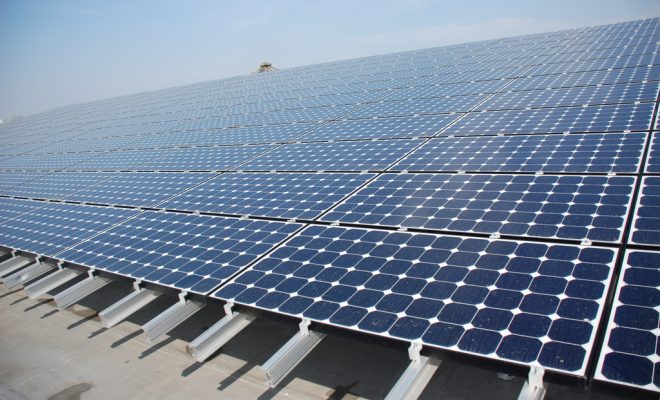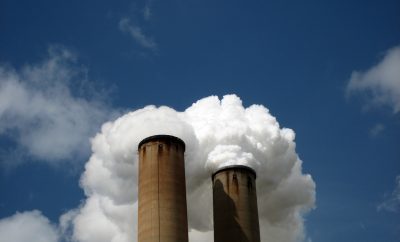 "Solar panels" by [Pete Jelliffe via Flickr]
"Solar panels" by [Pete Jelliffe via Flickr]
Energy & Environment
Microgrids: The Future of Smarter Grid Design and Energy Stability
The infrastructure that moves energy throughout the United States is called the macrogrid, a colossal system that provides power from 7,200 power plants to 120 million homes and businesses over 300,000 miles of transmission lines. While these numbers may be impressive, the macrogrid is actually one of the most outdated and inefficient pieces of critical infrastructure in the United States. Energy is lost through moving energy over long distances using aging power lines as well as when it is converted from AC to DC for electronic devices. The macrogrid is also particularly vulnerable to severe weather events, which caused 679 blackouts between 2003 and 2010 and cost between $18 to $33 billion annually in grid maintenance. The macrogrid has a huge job but its massive size and America’s complete dependence on it have created vulnerabilities in the nation’s energy system. Its interconnectedness means that if one part of the grid is damaged, everyone will suffer.
Microgrids: The Solution?
Enter the newly popular phenomenon of Microgrids. Microgrids are small energy distribution centers that are localized to a specific area, like a certain number of homes or businesses. Microgrids are normally attached to the macrogrid, but in the case of damage to the larger grid, a microgrid can separate and function independently, continuing to provide power to the buildings connected to it. Because of this ability, microgrids can offer a much higher level of energy security to Americans.
As a novel infrastructure design, microgrids also have the potential to benefit the environment in several ways. The first of these ways is by improved efficiency; power plants waste huge amounts of energy during production and additional power is lost during electrical conversion and movement through power lines. Because microgrids are localized to the areas they power, they simply need to transport their power over much shorter distances, which also allows them to skip over electrical conversions. Furthermore, microgrids provide opportunities for small-scale renewable implementation. Building large renewable projects–like wind farms or solar fields–can be incredibly expensive and often face opposition from a range of groups while requiring complex permitting processes. However, the compact and localized nature of microgrids drastically reduces these challenges, providing a new opportunity for increased clean energy distribution.
Hurricane Sandy: An Important Wake-up Call
The real impetus for microgrid policy started with Hurricane Sandy, an event so devastating that it required lawmakers to rethink the idea of energy security. Superstorm Sandy left 8.5 million people huddled without power for days, effectively immobilizing one of the world’s largest cities. Not only was energy shut off for homes and business, but critical structures such as hospitals and police stations were also cut off, meaning some of the most necessary community services were stripped of their functionality.
The metaphoric light in the dark came in the form of two microgrids in New York and New Jersey. The NYU microgrid kept power flowing to 22 buildings and heat to 37 buildings and the Princeton University Microgrid managed to provide power to a shocking 4,000 apartments, 35 high rise buildings, three shopping centers, and two schools for three days. The terrible damage caused by Sandy highlighted the serious vulnerability of our energy infrastructure and provided a powerful example of how microgrids can be useful.

“Hurricane Sandy power outage in Lower Manhattan, New York” courtesy of Lisa Bettany via Flickr
Different Models of Development
The majority of attention and investment in microgrids is happening in six states: New York, New Jersey, Connecticut, Maryland, California, and Massachusetts. It’s no coincidence that, with the exception of California, most of the states that have taken an interest in microgrids are in the Northeast–a particularly storm-vulnerable region of the United States. California actually stands out from these other states because it chose to commit primarily to renewable energy in its microgrid projects. In 2014, California state legislature dedicated $26.5 million to the construction of microgrids that heavily integrate renewables, with $6 million going directly to microgrids that could power electric cars. A large part of this policy decision was made in order to meet California’s aggressive statewide renewable energy target of 50 percent by 2020, and it stands out as one of the first states to see the technology’s potential for clean energy.
Unfortunately, California is unique in its environmental approach to microgrids, while the majority of states are dedicating the bulk of their research toward natural gas and diesel generators rather than solar, hydro, or wind. The primary concern of most states is reliability before clean energy production, which makes sense considering the fact that California doesn’t face the same threats to its energy security as the other areas. However, this does not mean that these microgrids won’t make an impact; by design, microgrids are more energy efficient than the traditional macrogrid and use energy in a more environmentally friendly manner.
Connecticut, New Jersey, and New York provide interesting examples of different policies for microgrid development. Connecticut was the first state to put serious money into the movement, holding a competition for the best microgrid designs and awarding $18 million in 2013 to nine different communities for the construction of microgrids. Connecticut followed this initial investment with a $15 million competition and currently leads the United States in terms of overall installed capacity. Connecticut’s competition funding method is a novel approach because the technology is so young and there’s very little research on the best possible ways to use it. By allowing different communities to design independent projects, the state acknowledged that the varying needs and geographic characteristics of different regions will require different microgrids. This also gives it an opportunity to see different approaches to the technology in action and get a sense of what the best possible approaches may be.
New Jersey, alternatively, decided to take a top-down approach to microgrid development and have the state Department of Energy decide where the funding should go, what models should be developed, and where they should go. The New Jersey transit system is the third largest in the world and provides the only public link between New York and New Jersey. Hurricane Sandy devastated the New Jersey transit system and, accordingly, it became the primary focus for microgrid development in the state. Governor Chris Christie dedicated $1 million for a project conducted by the New Jersey Public Utilities Board working together with the U.S. Department of Energy to construct a microgrid that could sustain the transit system. Since then, New Jersey has dedicated a staggering $200 million to their Energy Resilience Bank for the development of microgrids throughout the state.
In some ways, the Connecticut and Jersey models run parallel to one another. Connecticut (with a comparatively small amount of funds) allowed communities to do the research, design, and construction for their projects, requiring only that they build community service microgrids rather than single service projects. New Jersey, on the other hand, decided to let state departments perform all the work themselves and focused on one particular model: the Distributed Energy Resources Customer Adoption Model.

“Army Engineer Spur Development of Tactical Microgrids” courtesy of U.S. Army RDECOM via Flikr
In New York, following the devastation from Hurricane Sandy, Governor Cuomo and the New York State Energy Research and Development Authority (NYSERDA) began a massive effort to create the Reforming the Energy Vision, which was finally released in 2016. REV detailed plans to change the future of New York’s energy infrastructure and launched the New York Prize Microgrid Competition to promote the development of microgrids throughout the state.
New York based its plan on the Connecticut model of competition; however, New York stands out from other states because it made the unique decision to separate the competition into three stages. The very first stage awarded $100,000 to communities throughout the state to begin the design for their project. Feasibility studies are generally high-cost and high-risk projects because negative returns mean the initial investment was a waste. By removing the economic barrier of conducting the initial feasibility studies, New York allowed 83 communities (in contrast to Connecticut’s nine communities) to participate in this first stage competition, thereby creating an opportunity for many more microgrids to be built. The second stage awards $1 million for the design of the project and the final stage awards $10 million for the construction. While many of the communities that enter the first stage won’t progress to the second and third, NYSERDA predicts that once feasibility studies have already been designed, many communities that don’t pass on to the final stages will still be able to attract outside investors and complete their projects independently.
Potential Environmental Impacts
Do microgrids have promise as a pro-environment technology? Definitely, but it’s a little more complicated than that. Renewables have several major problems: they don’t produce a lot of energy, they don’t produce regular, reliable energy and they’re expensive. Wind only provides energy while the wind is blowing and solar only produces energy during the daytime. Hydropower provides more regular energy but has a nightmarish permitting process and is generally avoided for microgrid projects (only one of the 83 communities in the New York Prize Microgrid Competition tried to utilize hydro). While more and more battery systems are constantly being developed, current energy storage technology is just not advanced enough to make solar and wind storage effective to provide large amounts of power.
As a side note of interest, there are many engineers out there who believe that the next major energy revolution will come in the form of effective batteries, which would change the way we produce and utilize energy while making renewable energy endlessly more powerful. Unfortunately, we really aren’t at this point yet, which means that it’s very difficult for renewable technologies to be the sole energy provider for a microgrid, especially in the case of a serious outage. The reliability-first model of microgrid design means that the most important function of that model is its ability to support homes and businesses without fail in case of damage to the grid.
The cost of renewables is also a serious obstacle, but in a very different way than when constructing a large-scale solar or wind operation. The price per kilowatt of most renewables has actually dropped significantly, making them legitimately competitive technologies. However, microgrids are an inherently expensive project and most large utilities can already provide relatively low fossil fuel prices, at least for natural gas. In order to make a microgrid a cost effective project, a community must use technologies that will have power production and efficiency rates that are high enough that it makes economic sense not to buy energy from the macrogrid.
The technology that has taken the central role in microgrid development is cogeneration, also known as Combined Heat and Power. Normally up to 65 percent of energy is burned off as heat and wasted during production, which is a large part of the reason power plants are so inefficient. Cogeneration, however, traps this heat waste and uses it to provide thermal power to the areas it services. Energy from the grid–after production waste, conversion waste, and transmission waste–is typically between 20 to 25 percent preserved. Any given cogeneration unit can’t produce enough energy at the scale that a power plant can, making them inefficient for providing power to huge numbers of customers. However, cogeneration’s waste-heat recovery can produce energy with at rates up to 60 to 80 percent efficiency, making it the ideal technology to support a small, localized system. Cogeneration utilizes natural gas, but in a substantially more effective manner than the traditional macrogrid does. Natural gas fuel cells have also gotten attention for their high efficiency, although currently, it’s difficult to make them cost effective.
All of this doesn’t mean that renewables have no place in the microgrid movement. While California is the only state to dedicate their projects completely to renewable power, every state has a Renewable Energy Target and microgrids provide a great way to reach that target without large scale projects. New York, for instance, required each of its 83 communities designing microgrids to incorporate renewables in some way into their plans.
Renewables also combine well with other technologies. Solar generation can provide a significant source of energy during the day, but may not be able to meet peak electricity demand in the early evening. Because of this, solar and cogeneration can be combined to work well together. Cogeneration provides the “base load”–or the minimal amount of energy that will always be used consistently throughout the day–and solar can offset or even become a substitute during the day. In this way, natural gas provides stability while solar energy reduces emissions whenever possible.
Conclusion
While research and investment in microgrids are expanding, the movement is still developing and the technologies continue to evolve. It’s difficult to say exactly how the microgrid movement will progress and if it will spread to regions outside of the Northeast and California. It’s also difficult to predict whether policymakers will choose to stick with the popular bottom-up style of microgrid development or if they will go to the New Jersey route and choose to mandate certain models and patterns of development. There’s also the potential for large energy businesses like the fossil fuel industry to start to lobby against decentralized power and seriously impede progress.
However, the benefits of microgrids are very real. Americans depend on the outdated macrogrid for our daily lives and as the infrastructure grows older and storms become more frequent and more severe, we only become increasingly vulnerable. Microgrids provide a real opportunity to improve energy security throughout the United States and to produce energy in a more environmentally friendly way, both by increasing the efficiency of our energy sources and increasing the implementation of renewables.
Resources
Boeing: Introduction to Microgrids
Center for Climate and Energy Solutions: Cogeneration
E & E Publishing: LLC: Microgrids Become Reality as Superstorm Sandy’s Anniversary Nears
GreenTech Media: California Governor Jerry Brown Calls for 50 Percent Renewables by 2030
Greenbiz: New Jersey Becomes Latest State to Invest in Microgrids
Solar Schools: Advantages and Disadvantages of Renewables
Microgrid Knowledge: States Leading on Microgrids…California, Connecticut, Maryland (Part 1)
NYSERDA: NY Prize Microgrid Competition
Princeton University: Two Years After Hurricane Sandy, Recognition of Princeton’s Microgrid Still Surges
U.S. Energy Information Administration: Energy in Brief
Editor’s Note: This post has been corrected to clarify the way in which solar electricity can be with electricity from natural gas as well as the way energy is lost through transmission and conversion.








Comments